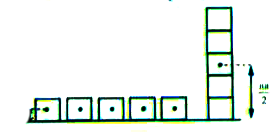Consider ..n.. number of indentical cubes each of mass ..m.. and side ..a.. lying on a level ground. Find the work done in piling them one above the other.
 Solution in Telugu
Solution in Telugu
The initial total potential energy of all the blocks lying on the ground is U1=n×mga2
The potentia energy, when the blocks are piled to form a single column is U2=nmgna2=n2mga2
∴ Work done in arranging the blocks one above the other is W=U2−U1
W=n2mga2−n×mga2(n2−n)
or W=mga2n(n−1)
Topper's Solved these Questions
- BOOK - AAKASH SERIESCHAPTER - WORK, POWER & ENERGY EXERCISE - EXERCISE - I78videos
WORK, POWER & ENERGY
- BOOK - AAKASH SERIESCHAPTER - WORK, POWER & ENERGY EXERCISE - EXERCISE - II (SCALARS (OR) DOT PRODUCT)9videos
WORK, POWER & ENERGY
- BOOK - AAKASH SERIESCHAPTER - WORK POWER ENERGYEXERCISE - EXERCISE - 361videos
WORK POWER ENERGY
Similar Questions
If l1,m1,n1 and l2,m2,n2 are the direction cosines of two vectors and θ is the angle between them, then the value of cos θ is
05:31View SolutionIf →P=2ˆi+3ˆj−4ˆkand→Q=5ˆi+2ˆj+4ˆk. Find the angle between the two vectors.
06:19View SolutionIf →A+→B=→Rand2→A+→B is perpendicular to →B then
02:27View Solution(a) Three particles of mass m each are placed at the three corners of an equilateral triangle of side a . Find the work which should be done on this system to increases the sides of the triangle to 2a , (b) Find work done in sending m to infinity.
09:23View Solutionn' identical cubes each of mass 'm' and edge 'L' are on a floor. If the cubes are to be arranged one over the other in a vertical stack, the work to be done is
07:11View SolutionA uniform rod of length 4 m and mass 20 kg is lying horizontal on the ground. The work done in keeping it vertical with one of its ends touching the ground, will be -
01:45View SolutionN similar slabs of cubical shape of edge b are lying on ground. Density of material of slab is p. Work done ot arrange them one over the other is -
05:08View SolutionFour indentical masses m are kept at the corners of a square of side a. Find the gravitational force exerted on one of the masses by the other masses.
06:11View SolutionIdentical cubes each of mass 'm' and side T' are on the horizontal surface.Then the minimum amount of work done to arrange them one on the other is
03:23View SolutionIf n number of identical cubes, each of mass m and side a lying on level ground. Find the work done in piling them one above the other.
03:06View SolutionTwenty identical cubical blocks each of mass 100 gm and of side 10 cm are lying on a horizontal surface. Work done in piling them one above the other (g=10ms^(-2))
03:23View Solutionn identical cubes each of amss m an side I are on the horizontal surface. Then the minimum amount of work done to arrange then one on the ther is
06:11View SolutionConsider ..n.. number of indentical cubes each of mass ..m.. and side ..a.. lying on a level ground. Find the work done in piling them one above the other.
 06:11View Solution
06:11View Solutionn identical cubes each of mass .m. and side .l. are on the horizontal surface. Then the minimum amount of work done to arrange them one on the other is
03:23View SolutionTwenty identical cubical blocks each of mass 100 gm and of side 10 cm are lying on a horizontal surface. Work done in pilling them one above the other is, (g=10 ms^(-2))
View Solution

